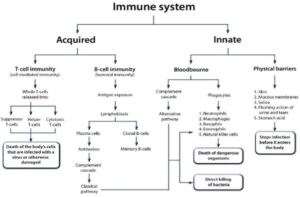“An Animal’s First Line of Defense”
The Innate Immune System is an animal’s first line of defense against foreign intruders like parasites, bacteria, viruses, yeast, fungus and molds.
In order for the Innate immune system’s principle defense mechanisms to function properly they require an optimum level of protein along with certain vitamins and minerals such as vitamins A, C, E, and B, as well as the minerals copper, zinc, manganese, and iron.
When this system is functioning properly, it recognizes foreign intruders and dispatches ‘killer’ T-cells, neutrophils, and monocytes to engulf, digest, and kill the intruders.
The Feline Immune System

Poor breeding habits, environmental influences, and the increased amount of stress placed on our pets accompanied by the lack of micronutrients vital to immune function can easily lead to a suppressed or compromised immune system.
In newborn kittens there exists an immunity gap from 4 -16 weeks, which is the primary cause for a high percentage of infant deaths. Vaccination schedules protect against specific diseases but only after the kitten is able to develop a significant number of antibodies and reach a safety threshold.
Many things can cause the immune system to become suppressed or compromised:
- Infants kittens who do not receive colostrum
- Kitten immunity gaps
- Highly infectious diseases like Parvovirus and Distemper
- Overuse of steroids and antibiotics
- Exposure to harmful chemicals
- Modified live vaccination response
- Protein, vitamin, and mineral deficiencies
- Hormonal imbalance
- Stress
Enhancing the Feline Innate Immune System
Protein quality is essential for maintaining the natural defenses in animals. Protein deficiencies, chronic disease or high levels of stress remove an animal’s ability to naturally fight off disease and protect themselves. Micronutrients such as vitamins, minerals, and related cofactors are also required to support the immune system.
ImmunoPro contains ingredients that prime the innate immune system and can be used as early as 4 weeks of age by mixing ImmunoPro with warm water and syringing it directly into their mouths. When weaned ImmunoPro can then be added directly onto their food.
Priming the Innate Immune System
Because the immune system as a whole begins to decline as animals age, priming the innate immune system can assist in protecting adult and senior cats from pathogens that could shorten their lives.
Supporting a cat’s immune system by priming it, as opposed to boosting it, means making it as strong as possible while keeping the animal body well. Supporting is a holistic concept that considers all of the immune system’s components and mechanisms of action. Supporting means compensating for natural, age-related declines in immunity, the effects of stress, and other conditions detrimental to good health. Supporting immunity means providing a cat with the tools it needs to remain healthy and live longer.
Research shows that the long chain Beta Glucan in ImmunoPro along with other key ingredients work to prime a cat’s innate immune system. Providing ImmunoPro supports immune health by activating macrophages, T-cells and neutrophils, the most abundant immune cells in a cat’s body, allowing them to move more quickly, seek out, recognize, and kill foreign disease causing intruders.
Nutritional Genomics
Nutritional genomics, also known as nutrigenomics, is a science studying the relationship between the animal genome, nutrition and health.
Science has demonstrated that a variety of phytonutrients including (Bacopa, Ashwagandha, Turmeric, and Milk thistle) are all potentially powerful activators of the Nrf2 protein. While not necessarily rich in antioxidants themselves, these phytochemicals directly affect a cats natural ability to produce vast numbers of new cellular antioxidants.
The proprietary blend of these four phytonutrients in ImmunoPro work synergistically to optimize the Nrf2 antioxidant activity within the cells of the cat.